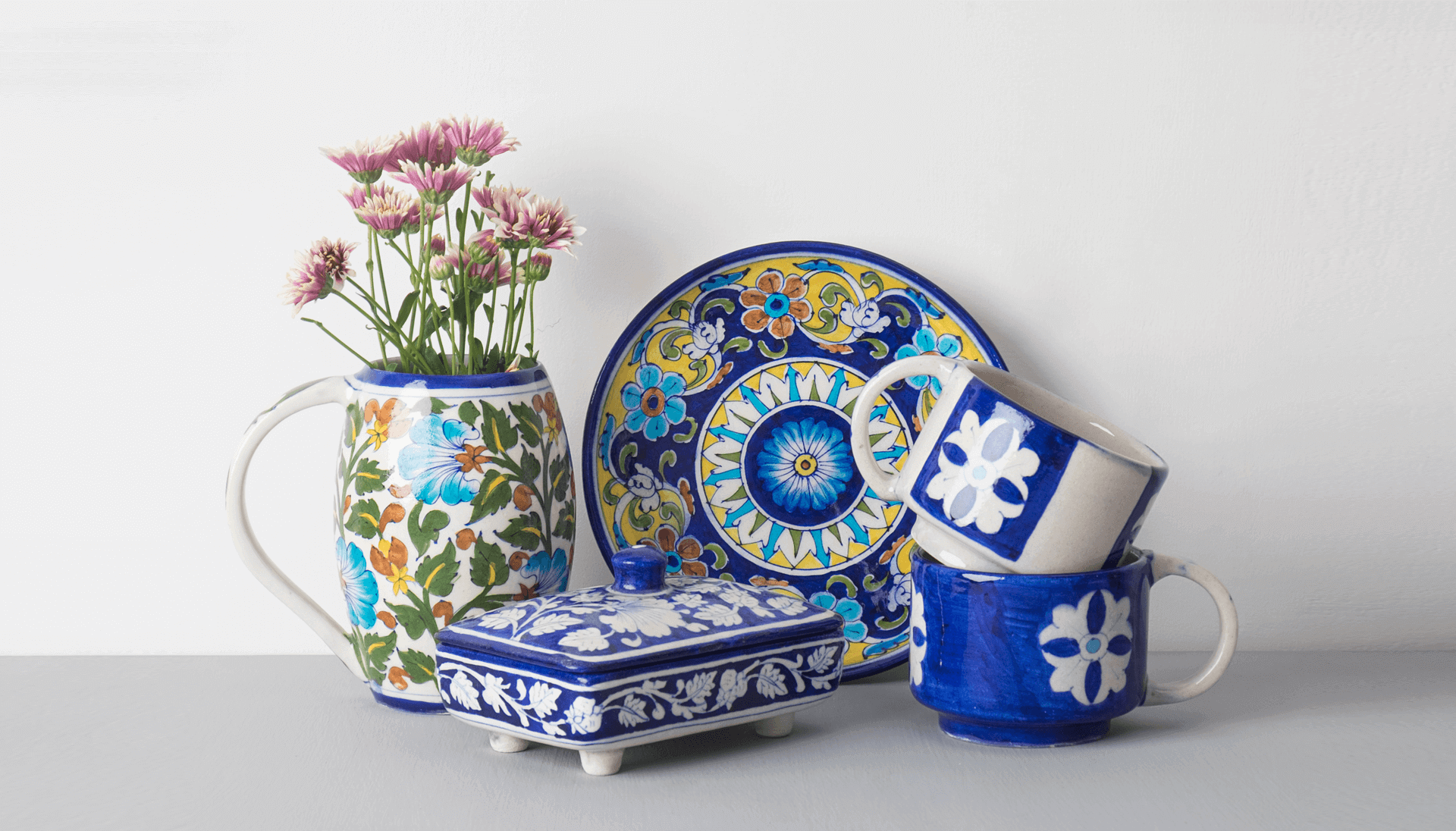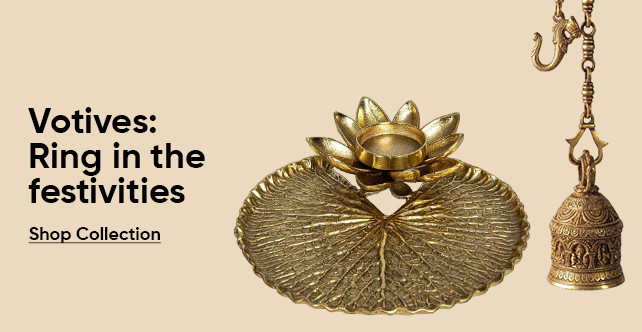Everything you need to know before buying blue pottery

A well known traditional craft of Jaipur, blue pottery came to the pink city only in the 17th century. Being Turko-Persian in its origin, the beautiful craft of blue pottery entered East India with Turkish invasions in the 14th century and later on flourished under the Mughal patronage. ‘Blue’ in blue pottery comes from the extensive use of cobalt blue dye to give the articles a stunning shade.
What makes blue pottery stand out from traditional pottery is the fact that clay is not used. The dough is carefully prepared using quartz stone powder, powdered glass, borax, gum, multani mitti (fuller’s earth) and water. Additionally, soda bicarbonate can be found in the mixture as well. The end product is carefully glazed using Chinese glazing technology.
Process
A consistent dough is prepared using the above-mentioned ingredients (borax, quartz stone powder, etc.) which is, later on, flattened using a traditional wooden tool called thepai. After making the dough section uniformly flat like a chapati, the dough is placed into moulds to make the desired shapes. For bigger pieces, it is preferred to use two or more moulds and stick them together using more clay and water. Instead of heating in a kiln, these new moulds are mostly kept in sun for 2-3 days to harden.
Once the articles are baked well, they acquire a sturdy form which is ready to be smoothened. The first step includes rubbing with sandpaper which is followed by immersing the article in a liquid solution to get rid of irregularities. After the immersing in the said solution, the article is again immersed in a solution of quartz powder, powdered glass and maida. This step ensures that the articles do not break easily. This step is again followed by rubbing with sandpaper to give the article a smooth texture.
Now comes the painting. Most of the blue pottery painters paint motifs inspired by the flora and fauna. Oxides and ferro metals are widely used with a binding gum to ensure that the paint doesn’t wear off. These colours give a stunning glow after being heated in a kiln.
After the paint is dried, the process of glazing begins. For this, a glaze solution is prepared using borax, zinc oxide, boric acid and potassium nitrate. This composition is heated at a high temperature which is followed by its cooling down in cold water. The solution undergoes a chemical reaction, giving rise to frits and these frits are finally mixed with cold water to form glaze. Glazing is evenly done with a thick coat to give a matte finish. Once the articles dry up, they are ready to be heated in a furnace.
Heating or firing takes place in a kiln for about 4-5 hours after which the kiln remains untouched to cool down for 2-3 days before removing the articles. In this process, some articles break while others come out as finished products.
Care
What makes the blue pottery stand out in handicraft items is that it never develops cracks and is quite hygienic to use. These properties make our blue pottery tableware a popular choice to serve food in. However, they can break if manhandled. The cleaning process is quite simple- wash gently with soap and water.
Blue Pottery and Culture
Also known as ‘Jaipur Blue Pottery’ at times, this craft has almost become synonymous with the culture of Rajasthan. Mrs. Leela Bordia (founder of Neerja International Foundation) has been working since 1978 to establish a big market for this beautiful Indian handicraft and uplifting the potters at the same time. A social enterprise by the name Aurea Blue Pottery has been set up by Ms. Roopal Banthia to revive the craft of blue pottery and help the craftsmen with marketing and designing. You can check out some of the beautiful pieces of this vibrant Indian handicraft with us.
Blue Pottery at Craft Maestros
On our visit to Jaipur, we couldn’t get our eyes off the beautiful lanes selling delicate pieces of blue pottery. After spending a quarter of our day exploring eye-catching products of blue pottery, we set off to meet our nationally awarded master artisan. His workshop reflected all sorts of possible colours and we knew that we have to be the mediator to get these shades adorned in the homes of our connoisseurs of art. Read on to know more about our blue pottery collection.
Blue Pottery Vases
Vases can do great both as a centrepiece and a corner decor accent. Blue pottery vases are known for their striking motifs and vibrant colours. Check out some of the blue pottery vases online at Craft Maestros here:
Blue Pottery Conch
Conches are believed to be very auspicious and one of the must-haves in your mandir. While brass and shell conches have established their places in our homely mandirs, blue pottery conches are no less when it comes to utility or aesthetics. Our collection of conches online are adorned with stunning floral motifs to amp up your mandir decor.
Blue Pottery Tealight Holder
Don’t we just love to decorate our homes with little tealights for mood lightning or special occasions? Our collection of blue pottery tealight holders online are handcrafted to perfection with flowery designs that reflect beautifully in the glow of a candle.
Hibiscus Flower Tealights (Set Of 2)
Cobalt Blue Tealights (Set Of 2)
Floral Round Tealights (Set Of 2)
Blue Pottery Jars and Bowls
To add some flavours of this exquisite craft to your kitchen counters, we have curated a fine collection of blue pottery jars and bowls online.
More From Our Collection
































